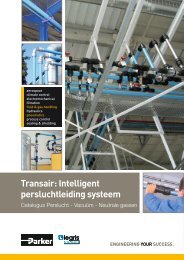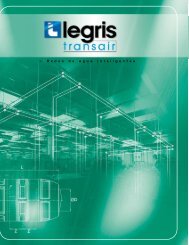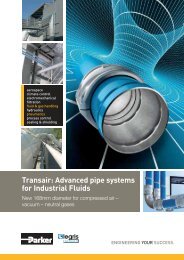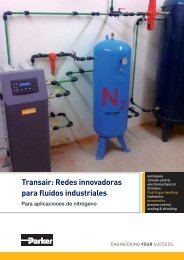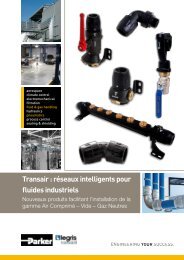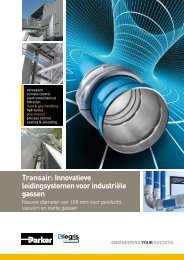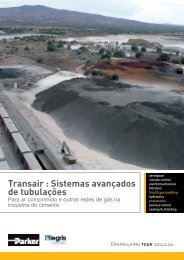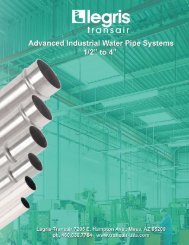Advanced Air Pipe Systems
Advanced Air Pipe Systems
Advanced Air Pipe Systems
Create successful ePaper yourself
Turn your PDF publications into a flip-book with our unique Google optimized e-Paper software.
Transair technology<br />
Ø 16.5 (1/2’’)<br />
Ø 25 (7/8’’)<br />
Ø 40 (1 1/2’’)<br />
<strong>Pipe</strong>-to-pipe and male connectors in Ø 16.5, Ø 25 and Ø 40<br />
can be immediately connected to Transair pipe - simply push<br />
the pipe into the connector up to the connection mark. The<br />
gripping ring of each fitting is then automatically secured and<br />
the connection is safe.<br />
seal<br />
gripping ring<br />
tightening marks<br />
body nut pipe<br />
Instructions<br />
1. Before installing Transair, a responsible<br />
person should check that the area of<br />
installation conforms to regulations<br />
designed to prevent the risk of explosion<br />
(in particular the risks associated with<br />
static electricity in silo zones).<br />
Transair’s flexible hose should be fitted at<br />
the beginning of the pipe system, in order<br />
to counter the vibrations found in any<br />
compressed air system. When maintaining<br />
or modifying a Transair pipe system, the<br />
work must be undertaken only after the<br />
compressed air system has been vented.<br />
The installer must use only Transair<br />
components and accessories, and in<br />
particular, Transair’s pipe clips. No other<br />
type of pipe mounting method is to be<br />
used. The technical characteristics of<br />
Transair’s components, as expressed in<br />
this brochure, must be respected.<br />
Ø 63 (2 1/2’’)<br />
Ø 76 (3’’)<br />
Ø 100 (4’’)<br />
Ø 168 (6’)<br />
<strong>Pipe</strong>-to-pipe and male connectors in Ø 63 can be quickly<br />
connected to Transair aluminum pipe by means of a double<br />
clamp ring. This secures the connection between the nut and<br />
the pipe - tightening of the nuts secures the final assembly.<br />
seal<br />
<strong>Pipe</strong>-to-pipe and male connectors in Ø 76 - Ø 168 can be<br />
quickly connected to Transair aluminum pipe. Position the<br />
pipes to be connected within the Transair cartridge and<br />
close / tighten the Transair clamp.<br />
lug<br />
double clamp ring<br />
body nut pipe<br />
socket head screw<br />
2. Once assembled, the operation of a<br />
Transair installation is the responsibility<br />
of the installer who, prior to use, must<br />
complete all necessary tests. The installer<br />
must also ensure that the installation has<br />
been properly carried out in line with the<br />
instructions and that it meets all legal<br />
requirements.<br />
3. Care should be taken to protect pipe<br />
against mechanical shocks – especially<br />
when close to the passage of forklift<br />
trucks or where suspended objects are<br />
being moved. All excessive rotational<br />
movements, which could lead to<br />
disconnection, whether on the pipes or<br />
the supports, must be avoided. Transair’s<br />
flexible hose must be used in accordance<br />
with the instructions in this brochure.<br />
4. The performance of a Transair system<br />
is maintained when the effects of<br />
expansion or contraction are properly<br />
taken into account.<br />
5. To ensure proper installation, Transair’s<br />
components are supplied with an<br />
assembly guide. The installer must follow<br />
with care the precise instructions as<br />
described in this guide as well as this<br />
brochure.<br />
seal<br />
cartridge clamp pipe<br />
Scan QR tag to see an installation video for each diameter on any mobile device with a QR reader app.<br />
6. When suspending from a ceiling,<br />
Transair’s pipe clips should be fixed to a<br />
support (U channel, cable tray, threaded<br />
rod, etc). This type of support ensures that<br />
the clips stay in alignment, which allows<br />
the pipe to expand and contract.<br />
7. When using Transair, the following<br />
situations must be avoided:<br />
• Installation within a solid mass<br />
(concrete, injected foam)<br />
• The hanging of any external equipment<br />
to Transair pipe<br />
• The use of Transair as an electric<br />
grounding, or to support electrical<br />
equipment<br />
• Exposure to chemicals that are<br />
incompatible with Transair<br />
components.





